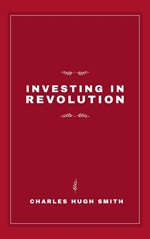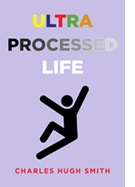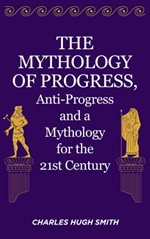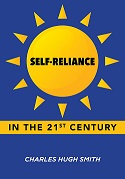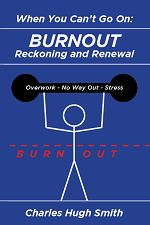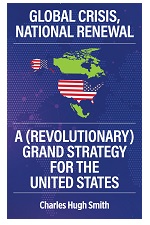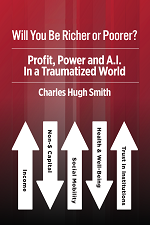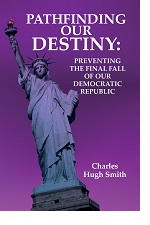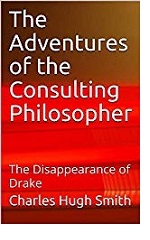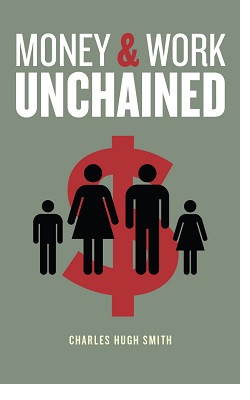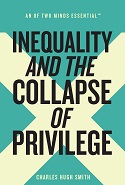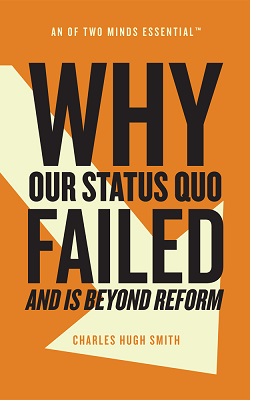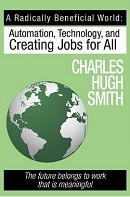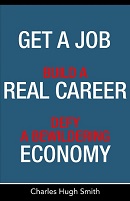Two Charts of Extremely Perverse Incentives
As a thought experiment, consider these changes to our economy's incentive structure.
Warren Buffett's partner Charlie Munger had a maxim: Show me the incentives, and I'll show you the outcome. With that in mind, let's look at two charts.
The first is a chart depicting the use of ChatGPT. (Source:
OpenAI Usage Plummets in the Summer, When Students Aren't Cheating on Homework.)
Usage fell by 2/3 once classes ended, and the dips in use during the Spring align with weekends.
There are any number of conclusions we can draw, but let's start with another of Munger's maxims: why? The reason is obvious: students are required to do homework as part of the learning process, and are incentivized to complete their homework so they pass the class.
So they use generative AI tools to either help them complete their homework or do their homework for them.
We can't tell which option they selected without testing their knowledge without any digital devices within reach to help them.
Note the incentives are to complete the homework, not to master the material. That's a big difference, and it's the foundation of our entire system of education: pass the class, accumulate credits, and you will be issued a credential / diploma certifying that you passed X number of classes.
This incentive leads to students learning very little despite spending a fortune and four years attending college courses. Consider the study Academically Adrift: Limited Learning on College Campuses which concluded that "American higher education is characterized by limited or no learning for a large proportion of students."
The institutions of education are incentivized to issue credentials that cost a lot of money and time.
The causal link between learning and doing homework is now weak, as generative AI can do their homework for them.
The obvious solution is to issue educational credentials only for passing exams given in real time without any digital devices allowed. In other words, test the students' actual learning / knowledge, rather than tote up homework completed and classes passed.
In other words, accredit the student, not the institution. This was a key suggestion in my book
The Nearly Free University.
The testing would have to be lengthy and clever enough to demand real mastery rather than superficial recall / memory, and it would have to be closely guarded and the component exams would have to be issued semi-randomly to each student at the moment the testing began, to minimize gaming the test or cheating.
In this incentive system, if a well-educated 17-year old passed the entire battery of university accreditation tests, they would be issued a university diploma without attending a single class because the system accredits the student, not the institution.
In my book Get a Job and Build a Real Career, I take this one step further, outlining a path to accredit yourself.
What the existing system incentivizes is becoming dependent on generative AI while learning very little because there is little incentive for actual learning. There are also no incentives for those within the institutions to focus on students learning essential skills and knowledge.
Imagine if the wildly unproductive belief that "everyone has to go to college" was replaced with a system that enabled students to choose to learn skills on a broad spectrum, from welding to calculus.
Imagine if every employee in the school / university received minimum-wage paychecks if the students learned very little and received a bonus if the students passed rigorous tests documenting that they'd learned skills and knowledge that are useful in life and in the real economy.
Imagine if every student who passed the tests was given a paid internship in their field of choice.
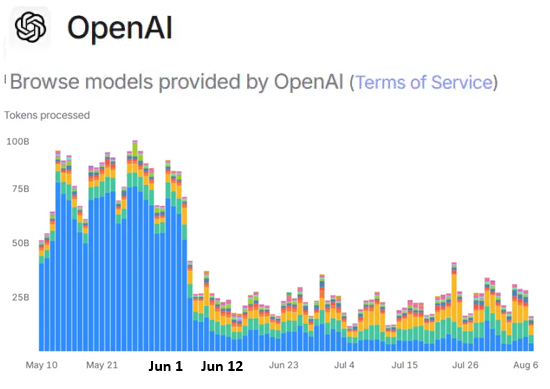
Instead, we incentivize students in insert typos into their chatbot-composed papers to make it appear that they actually wrote the paper themselves. If we want a more productive outcome, we have to change the incentive structure of the entire education complex.
Next up: stock buybacks, which were only legalized in 1982 at the start of America's great hollow out the real economy to benefit the few experiment, also known as Financialization. (Source:
American Companies Are Buying Their Own Stocks at a Record Pace
Buybacks are expected to top $1.1 trillion in 2025, led by big banks and tech firms (in other words, the usual suspects.)
The approved narrative seems to be that Corporate America would be investing these trillions in new productivity, except for all this uncertainty about tariffs. But this explanation conveniently ignores the enormous annual buybacks that preceded the present tariff kerfuffle.
The real issue is the incentives favor financialization, not investing in real-world productive assets.
As a thought experiment, consider these changes to our economy's incentive structure:
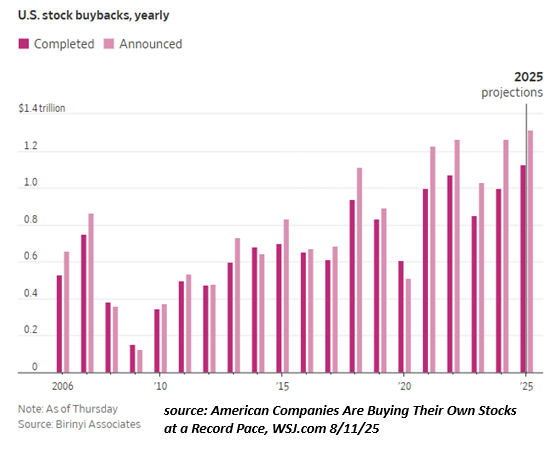
1. Buybacks are taxed at a rate of 50%. If you want to buy back $1 of your company's shares, you pay $1 in tax. So Corporate America's $1.1 trillion in buybacks would generate $550 billion in taxes and a net $550 billion in shares purchased via buybacks.
2. Profits earned from domestic production are tax-free. Given the complexities of global supply chains, there has to be some wiggle room here, so if 80% of all components and labor are domestic, this qualifies for the zero tax rate.
How would changing the incentives change Corporate America's decisions regarding where they invest their profits? If we want to change the outcome, we have to change the incentive structure.
The problem, as we all know, is those with vested interests in maintaining the current perverse incentives hold all the power, and they have zero incentive to relinquish any of that power.
Check out my new book Ultra-Processed Life and my updated Books and Films.
Become
a $3/month patron of my work via patreon.com
Subscribe to my Substack for free
My recent books:
Disclosure: As an Amazon Associate I earn from qualifying purchases originated via links to Amazon products on this site.
Ultra-Processed Life print $16, (Kindle $7.95, Hardcover $20 (129 pages, 2025) audiobook Read the Introduction and first chapter for free (PDF)
The Mythology of Progress, Anti-Progress and a Mythology for the 21st Century print $16, (Kindle $6.95, audiobook, Hardcover $24 (215 pages, 2024) Read the Introduction and first chapter for free (PDF)
Self-Reliance in the 21st Century print $15, (Kindle $6.95, audiobook $13.08 (96 pages, 2022) Read the first chapter for free (PDF)
When You Can't Go On: Burnout, Reckoning and Renewal $15 print, $6.95 Kindle ebook; audiobook Read the first section for free (PDF)
Global Crisis, National Renewal: A (Revolutionary) Grand Strategy for the United States (Kindle $6.95, print $16, audiobook) Read Chapter One for free (PDF).
A Hacker's Teleology: Sharing the Wealth of Our Shrinking Planet (Kindle $6.95, print $15, audiobook $17.46) Read the first section for free (PDF).
Will You Be Richer or Poorer?: Profit, Power, and AI in a Traumatized World
(Kindle $3.95, print $12, audiobook) Read the first section for free (PDF).
The Adventures of the Consulting Philosopher: The Disappearance of Drake (Novel) $3.95 Kindle, $12 print); read the first chapters for free (PDF)
Money and Work Unchained $6.95 Kindle, $15 print) Read the first section for free
Become a $3/month patron of my work via patreon.com.
Subscribe to my Substack for free
NOTE: Contributions/subscriptions are acknowledged in the order received. Your name and email remain confidential and will not be given to any other individual, company or agency.
|
Thank you, Kerjanga N. ($70), for your exceedingly generous subscription to this site -- I am greatly honored by your support and readership. |
Thank you, Mark W. ($7/month), for your marvelously generous subscription to this site -- I am greatly honored by your support and readership. |
|
|
Thank you, Nikolai ($7/month), for your superbly generous subscription to this site -- I am greatly honored by your support and readership. |
Thank you, John G. ($7/month), for your splendidly generous subscription to this site -- I am greatly honored by your support and readership. |


